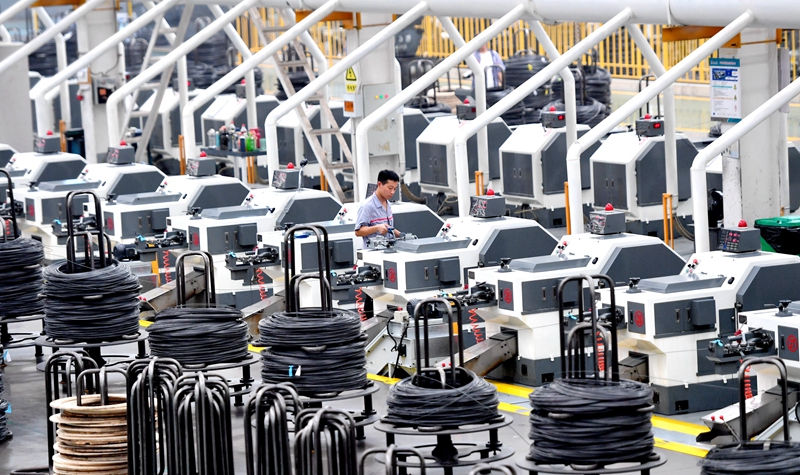By Einar Tangen Source:China.org.cn 2024-08-19

A worker works at an intelligent digital workshop of a fastener manufacturing company in Yongnian district of Handan, north China's Hebei province, Aug. 16, 2024. [Photo/Xinhua]
China's contribution to the world has two distinct phases.
In the past, China contributed to the world by inventing paper, after which books, kites and paper money were possible. It pioneered iron and bronze production allowing the creation of seed drills, row planting, movable type, the compass, mechanical clocks and earthquake detectors. Gunpowder changed the military balance of power, while tea, porcelain and traditional Chinese medicine altered how people lived. Intellectually, a variety of influences, including Confucianism, Buddhism and Daoism, influenced the way people thought.
The opening up policy of the late 1970s was embraced because China needed to learn if it was going to rejuvenate the country, and signaled the second phase of the country's major contributions to the world. Between the late 1970s and 2000, China was a student, its best and the brightest venturing abroad to seek knowledge and understand the modern world.
Between 2000 and 2010, China transitioned from student to partner, contributing through joint research and development programs to the understanding of particle physics with scientists like the Nobel laureate Tsung-Dao Lee and the "First Lady of Physics" Wu Chien-Shiung.
Since 2010, China, while still learning, has become an innovator and teacher. It now leads the world in research publications recognized as high quality, and produces many more engineers than the United States. By all measures, research spending in China is soaring.
In March 2023, the Australian Strategic Policy Institute (ASPI) stated that China is leading in 37 of 44 critical or emerging technologies.
China has accomplished this by creating research institutions, investing in research and development, and relying on the hard work and competitive forces that have taken it to the forefront of applied technology in consumer driven markets like cellphones and appliances. It has also established economic and technological development zones, industry clusters and joint ventures that quickly move innovations from the mind to the consumer.
In medicine, China's researchers and doctors moved from learning to mastering and teaching microsurgery, developing carbon ion therapy, implantable left ventricular assists, implantable sacral nerve stimulation, endoscopic single-site surgery systems, and the rapid genome sequencing and development of multiple COVID-19 vaccines.
In communications, the inexpensive cellphones powering the economies of developing nations; 5G and 6G, cloud computing, electronic mobile payments systems, IOT and sensors, continue to change the way the world accesses, uses, orders and pays for information.
In engineering, the rapid and cost-effective transformation of China and other countries through infrastructure projects that link and empower people and countries, has created opportunities allowing developing nations to outgrow the developed nations that once controlled them.
On a human scale, China's scientific advancements have been and continue to be shared through various government programs, like eradicating extreme poverty and expanding the safety net in terms of health and pensions. The systems that support these projects have been developed over years, involving social credit score systems that identify those who engage in fraud and rewards those who do not.
Unfortunately, China's advancement is seen by the United States as a threat to its dominance and hegemony – a dominance long maintained by hoarding scientific and technological developments, while seeking often exorbitant rents.
In 2018, the Trump administration rolled out its "China Initiative," signaling the end of an era of open learning and cooperation not only between the U.S. and China, but the entire world. The Biden administration has continued along the same trajectory, with failed prosecutions of Chinese scientists, and restrictions on finance, technology, companies and individuals, repeating daily the mantra of the China security threat.
Since 2018, joint publications have dropped in overall numbers worldwide, Chinese academics are less willing to come to the U.S., and Chinese researchers in the U.S. are increasingly likely to return home. In 2023, the number of joint research papers between American and Chinese scientists dropped for the first time in three decades. At a time when science is sorely needed to solve climate, energy and health issues, the U.S. is shutting the door to China and the rest of the world.
On the question of whether you should control or share knowledge, on one side are politicians who know little about science and believe it should be controlled, while on the other side, is the vast majority of scientists who understand that it needs to be shared.
In 2014, Francis Collins, president of the National Institutes of Health (NIH), speaking at Fudan University in Shanghai, said, "Science has no borders because knowledge belongs to all humankind."
China has now graduated and will continue to learn and share, contributing to a world of shared values and progress – the only question is will it be met with more resistance or embraced? As one door on the U.S. side closes, China's door continues to open wider.
Copyright © Xizang Daily & China Xizang News All rights reserved
Reproduction in whole or in part without permissions prohibited
Index Code: 藏 ICP 备 05000021 号
Producer: Xizang Daily International Communication Center